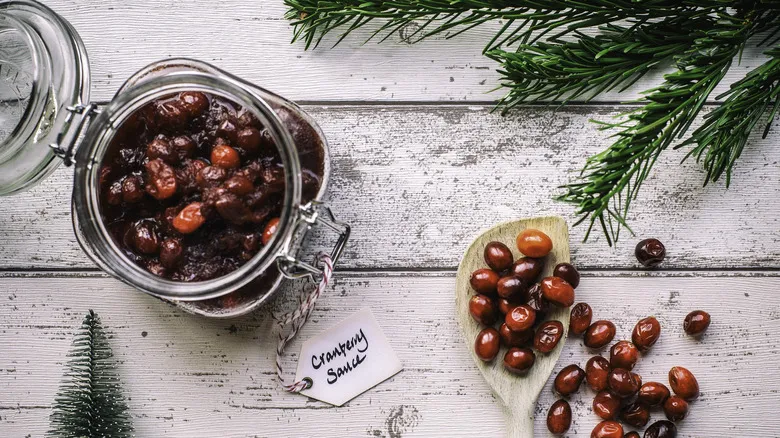Cranberries are a true berry
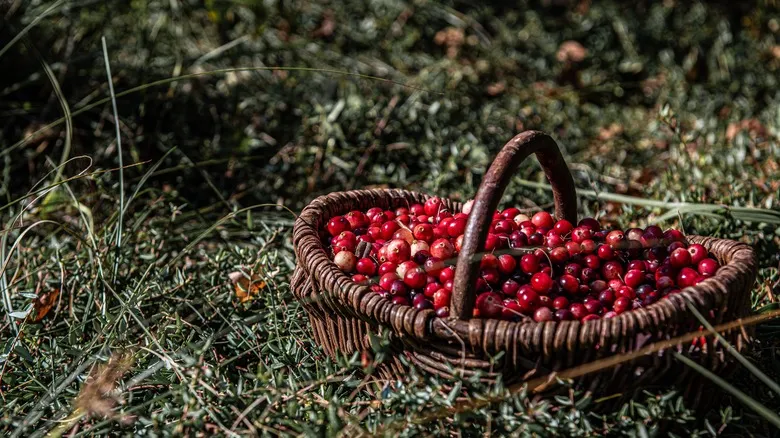
Just because something is labeled a berry doesn't mean it truly qualifies as one. Take the strawberry, for instance; it's actually a pseudocarp, or false fruit. This sneaky strawberry is composed of numerous tiny fruits fused together into a large, fleshy mass. (Just a side note: kind of gross.)
In contrast, cranberries (Vaccinium macrocarpon) are genuine berries. "This means they develop from a single ovary of a flower, resulting in a simple, fleshy fruit," explains Jennifer Pallian from Foodess. "Cranberries are part of the Ericaceae family, which includes other true berries like blueberries, making them authentic botanical berries by their structure." In other words, unlike the deceptive strawberry, cranberries can be relied upon.
However, their growing conditions are less straightforward. Contrary to popular belief, cranberries don’t actually grow in water. Instead, marshy bogs are flooded during harvest time to help float the cranberries, making them easier to collect. Additionally, you might want to reconsider spending time in cranberry bogs: humans are just one of the many inhabitants, with bog spiders being another. Yes, you read that correctly—bog spiders. It’s not as pleasant as it sounds.
Turns out cranberries are great at gelling

Cranberries are known for producing a wonderfully thick sauce, and there's a good reason for that. According to Jennifer Pallian, "Cranberries are rich in pectin, a type of polysaccharide that serves as a gelling agent. Pectin, which is present in the cell walls of plants, creates a network that captures sugar molecules during cooking, resulting in a gel-like texture. The naturally low pH of cranberries activates the pectin, promoting gel formation." Therefore, their acidity is an advantage.
However, there are times when cranberry sauce could use a little extra assistance. If you're aiming for a firm sauce that can be sliced, similar to the canned version, you'll need to add some additional pectin to achieve that gel-like consistency. The more pectin you incorporate, the thicker and more stable the sauce will be, allowing it to hold its shape on a spoon instead of turning into a mushy mess. Alternatively, you can opt for a simpler sauce made with just cranberries and sugar, which will thicken nicely for drizzling over turkey.
Cranberry sauce is an invention for the ages
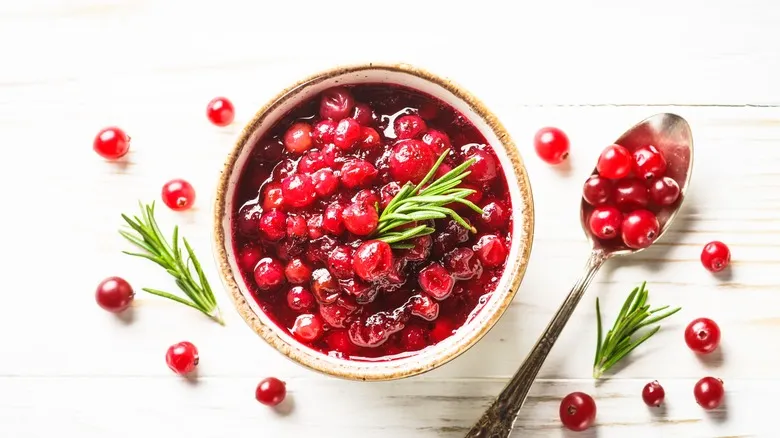
While many white Americans view cranberry sauce as a cherished European custom, it was actually first cultivated and revered by Indigenous peoples in North America. Long before it accompanied Brussels sprouts and mashed potatoes, the Aquinnah Wampanoag and other tribes grew, harvested, and celebrated this fruit. This is why it holds a significant place at the table for Indigenous Peoples' Day.
However, its story didn't stop there. We owe the widespread presence of cranberry sauce at holiday gatherings to an American entrepreneur. Marcus L. Urann, a former lawyer who became a cranberry bog owner, realized he could significantly extend the six-week cranberry season by learning to can the fruit, and he was absolutely correct. Now, cranberry sauce is available year-round. Regardless of your opinion on the canned version (which can be as divisive as Thanksgiving itself), it’s always there if you desire it.
There's a difference between sauce and jelly

Here’s an important distinction to keep in mind about cranberry sauce: it differs from jelly. "Sauce contains whole or crushed berries and has a spoonable texture, whereas jelly is smooth and more spreadable," explains Marissa Stevens from Pinch and Swirl. The choice between the two ultimately depends on the texture you prefer and how you intend to use it. "I prefer sauce for the dinner table and jelly for turkey sandwiches the next day."
Jennifer Pallian elaborates on this by noting that cranberry sauce is chunkier, featuring whole or halved cranberries, which contributes to a bolder flavor and a rustic, farmhouse feel. In contrast, cranberry jelly is smooth and clear, created by straining out solids and then setting the liquid with sugar (and sometimes pectin) for a firm, sliceable result.
As a helpful tip, Duff Goldman suggests a trick for getting the perfect canned cranberry jelly: after opening the can, poke a hole in the back to allow air in. This will help the jelly slide out in that ideal canned shape, making it easy to slice into attractive rounds for your table presentation.
It's easy to make cranberry sauce
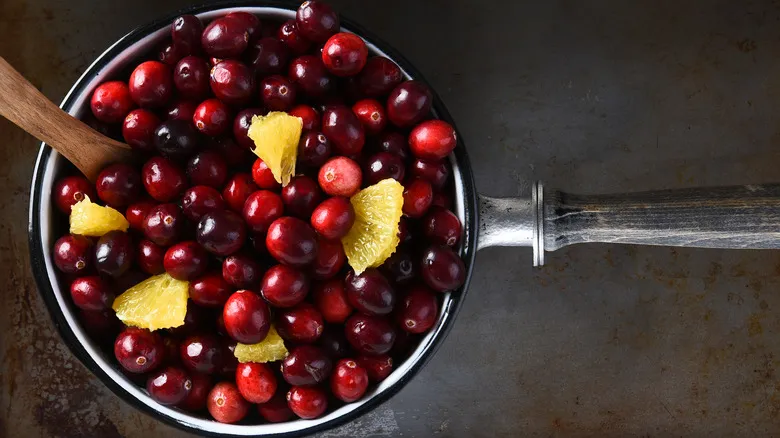
Creating your own cranberry sauce is incredibly easy. Compared to the effort involved in preparing a turkey or the frustrating uncertainty of boiling potatoes, it’s a breeze. A simple sauce only requires five ingredients: cranberries, water, sugar, vanilla, and an orange (for both its juice and zest).
Here’s a straightforward recipe from Marissa Stevens: "Combine 12 ounces of cranberries, 1 cup of sugar, and just enough water or orange juice to get things started. Cook until the berries burst and the mixture thickens, which should take about 10 minutes. You can keep it chunky, mash it to your desired consistency, or strain it for a smoother texture. The choice is yours." And for those who appreciate the ease of slow cooking, you can also prepare cranberry sauce in an Instant Pot—or any slow cooker, for that matter. With the Instant Pot, you can whip up the sauce in under 30 minutes without any mess.
If you want to elevate your sauce, Stevens suggests adding some extra ingredients. Fresh or dried fruits like apricots, currants, and cherries can give your sauce a unique twist. Nuts such as almonds, hazelnuts, and walnuts can add a rich flavor, as can cognac and orange liqueur. Alternatively, you can replace vanilla extract with almond extract for a buttery, nutty taste.
Fresh, dried, and frozen cranberries all work
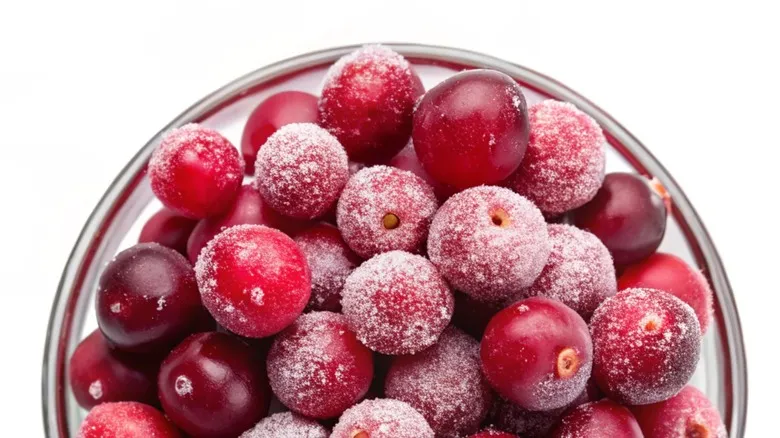
When it comes to your essential ingredients, you have several choices: fresh, frozen, and dried. Believe it or not, you can even whip up cranberry sauce using plain dried cranberries, also known as craisins. They rehydrate beautifully when combined with cranberry juice, orange juice, sugar, and a touch of cornstarch to thicken the sauce.
According to Marissa Stevens, fresh cranberries are the obvious choice, but they are only available from October to December. "Frozen berries are typically more affordable and can be found year-round. Since you’re cooking them anyway, you’ll hardly notice any difference in texture." A helpful tip from her: buy extra fresh berries and freeze them yourself. This way, you can ensure they were at their peak ripeness when you stored them. "They can last for up to a year!"
However, when using frozen berries, you might need to make a few tweaks. Jennifer Pallian notes, "Substituting frozen cranberries for fresh can result in slight variations in texture and consistency. Frozen berries tend to release their juice more easily because of the breakdown of cell walls during freezing, which can make the sauce a bit thinner and may require a longer cooking time to reach the same thickness as with fresh berries." Fortunately, she adds, the flavor remains largely unchanged, as the cranberry taste is mostly preserved through freezing. "I personally use whatever I have on hand and don’t notice a significant difference that would make me prefer fresh cranberries over frozen."
You can level up canned sauce
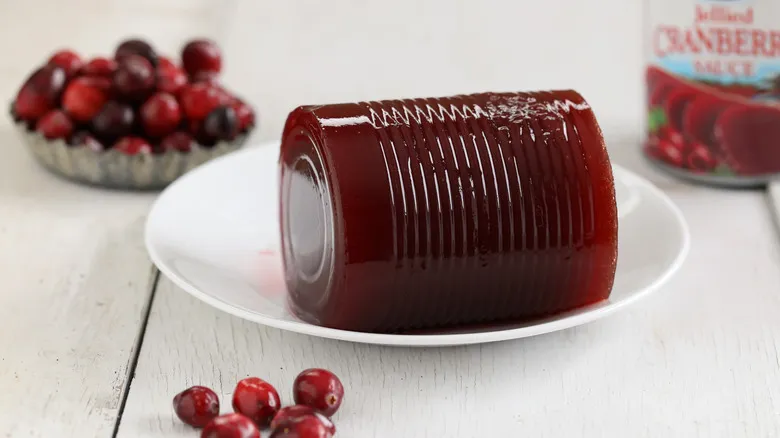
One of the greatest advantages of cranberry sauce is its simplicity. While making it from scratch is straightforward, there's an even easier option: opening a can. Even if you haven't fully embraced the idea of Thanksgiving catering, there's no harm in saving some time and effort by opting for canned sauce. The best part? You can easily elevate your canned sauce to taste homemade with minimal effort.
For whole berry sauce, Marissa Stevens suggests, "Gently warm it with cinnamon and fresh ginger. You can also mix in fresh orange zest and a splash of juice, or add diced apples or pears." For jellied sauce, "Heat and whisk until smooth. Incorporate vanilla or almond extract, along with citrus zest and a small splash of juice (just be careful not to make it too runny)." Anything you would typically add to a homemade sauce can also enhance a canned version. It may sound unusual, but toasted nuts can add wonderful texture to cranberry sauce. Think of it less as a traditional sauce and more like a chutney. If turkey and cranberries feel a bit mundane, this is a fantastic way to elevate the dish.
If you prefer to avoid excessive tartness, you can balance your cranberry sauce with a hint of spice. For a subtle kick, consider warming spices like cloves and nutmeg, reminiscent of chai tea or pumpkin pie. For a bolder flavor, try Aleppo or Espelette pepper, which provide heat without overwhelming intensity. If you're looking for a real kick, bird's eye chili or chipotle will certainly do the trick.
Other sweeteners will work
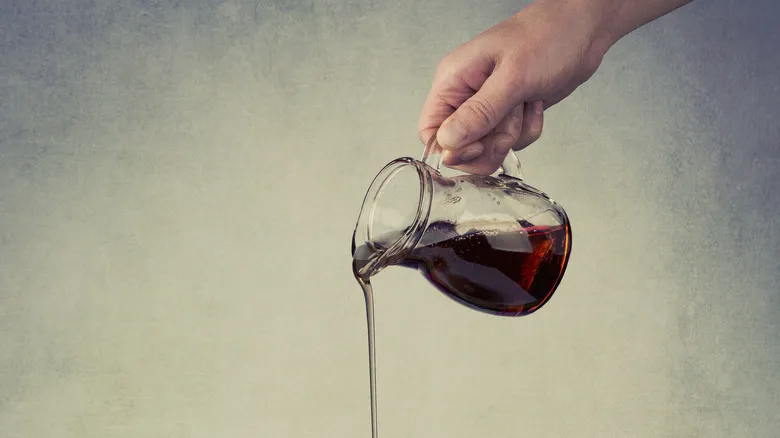
Are you curious about how to make cranberry sauce a bit healthier? Well, it's possible, but there are some trade-offs when replacing sugar.
Jennifer Pallian explains, "Generally, the high sucrose content in white sugar is ideal for creating a strong gel with pectin, so 'healthier' alternatives may not perform as well." For instance, maple syrup and honey contain less sucrose and have a higher water content, which can hinder pectin's gelling ability. This extra moisture might result in a looser sauce, so you may need to add a bit of pectin to achieve the desired consistency. It's also worth noting that these substitutions can alter the final flavor.
If you're looking to reduce calories while still enjoying sweetness, consider using monk fruit sweetener. Monk fruit (Siraitia grosvenorii), also known as lo han guo or swingle fruit, is a high-intensity sugar alternative that offers plenty of sweetness. In my experience, it has a slightly unusual taste, but when mixed with other strong flavors like pumpkin and butter, it's hardly noticeable. However, similar to other substitutes, you might need extra pectin to ensure proper gelling.
People make several mistakes with cranberry sauce

We all make errors in the kitchen, and one of the most common is letting your sauce burn at the bottom of the pot. (I admit, I've done it too.) This first mistake can be easily avoided by keeping a close watch on your sauce and preparing it in advance instead of during the hectic final meal preparations. However, you can also spoil your sauce before it even reaches the burning stage.
"One frequent error with cranberry sauce is overcooking, which breaks down the pectin and leads to a watery consistency. It might seem counterintuitive," explains Jennifer Pallian. "Another mistake is improvising with the ingredients. Achieving the right balance in a gelled sauce requires precise ratios of sugar and acidity."
But that's not all, as Marissa Stevens points out. There are additional missteps that can affect the quality of your sauce without completely ruining it. These include not using enough sweetener and selecting the wrong texture based on how you plan to serve it. Additionally, she emphasizes the importance of fresh cranberry relish, which is delightful. "I prepare mine with a whole orange (peel included), fresh or frozen cranberries, walnuts, honey, and a splash of orange liqueur. It brings a vibrant, fresh flavor to your Thanksgiving table, and the leftovers are fantastic on sandwiches." You can find the recipe on her blog.
Cranberry sauce has lots of health benefits
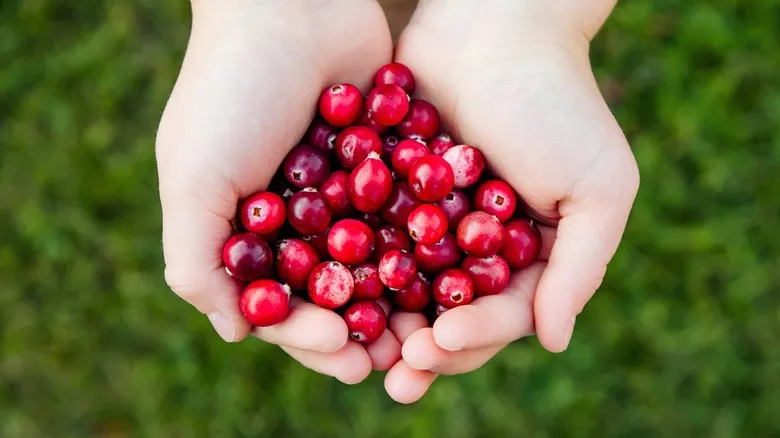
Health foods are often scarce during holiday feasts, but cranberries stand out as a healthy option. "Cranberries are rich in polyphenols, which provide a strong antioxidant effect that supports overall health and may help in disease prevention," explains Jennifer Pallian. Additionally, "Consuming cranberries regularly has shown potential benefits in reducing urinary tract inflammation in both adults and children."
While many are aware of cranberries' ability to combat urinary tract infections, you may be surprised to discover their potential benefits for other parts of the body, particularly the gastrointestinal tract. "Cranberries may possess antibacterial properties and could help alleviate stomach infections," Pallian notes, "including those caused by Helicobacter pylori bacteria." So, the next time you feel the onset of the flu or an ulcer, consider sipping on some cranberry juice—it might just provide the relief you need.
As if that weren't enough, cranberries are also packed with polyphenols, which are potent antioxidants. These compounds not only help neutralize free radicals from UV exposure and pollution but also play a role in fighting cancer, diabetes, heart disease, and neurodegenerative disorders. Cranberries truly are a powerhouse, but that's not all they offer.
It's a (fairly) healthy holiday food

Admittedly, any dish that relies heavily on white sugar isn't exactly the epitome of health. However, when you consider the typical accompaniments of cranberry sauce—like mashed potatoes and gravy, stuffing, crescent rolls, and sweet potato pie—it starts to seem quite wholesome in comparison.
With just 50 calories per cup of chopped cranberries, there are notable nutritional advantages. A mere 100 grams (roughly equivalent to a cup) provides 35% of the daily recommended intake of vitamin C, along with modest amounts of B6 and potassium. For this reason, it's wise to pile your holiday plate high with cranberry sauce. After the main feast, you can repurpose any leftovers in recipes like cranberry sauce coffee cake and convince yourself it's a healthy choice. I'm pretty sure your doctor would approve!
Sauce lasts a long time

Store your cranberry sauce properly, and it can last for a long time. It's not just delicious the day after Thanksgiving, when leftover sandwiches make their debut, with cranberry sauce acting as the perfect binder (a sandwich affectionately known as the Bobbie). If you manage your storage well, you can savor it throughout the fall and winter months.
Begin by ensuring your cranberries are stored correctly. Dried cranberries should be kept in a cool, dark location, away from light and moisture. Frozen cranberries can be stored in the freezer for up to a year, while fresh cranberries will remain good for about two weeks in the refrigerator.
When it comes to cranberry sauce, it can be refrigerated in an airtight container for up to two weeks. It also freezes well for up to two months, which is ideal for prolonging the cranberry season, according to Marissa Stevens. Be sure to use containers with tight seals to keep out oxygen, bacteria, and any unpleasant refrigerator odors.
Recommended

How To Store Avocado Oil For The Longest Possible Shelf Life
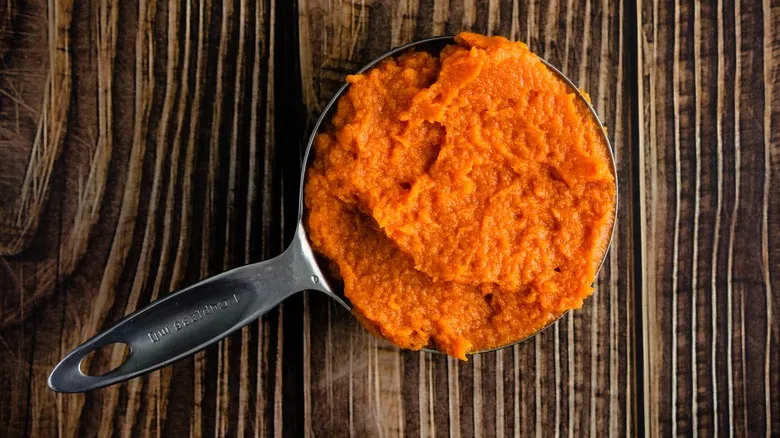
The Best Way To Freeze Canned Pumpkin For Later
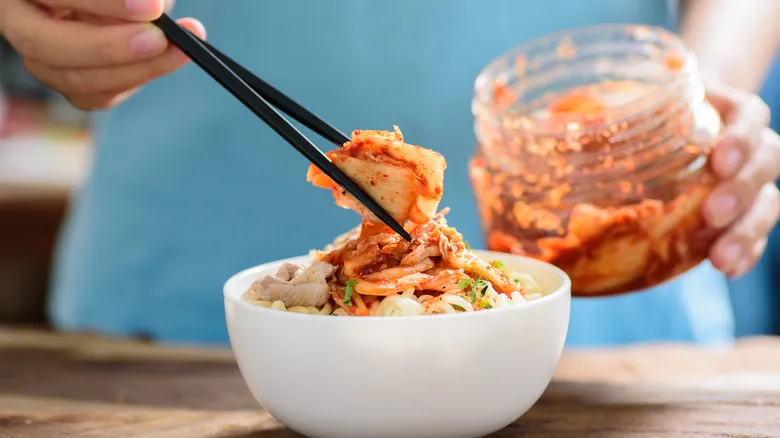
The Absolute Best Temperature To Store Kimchi At
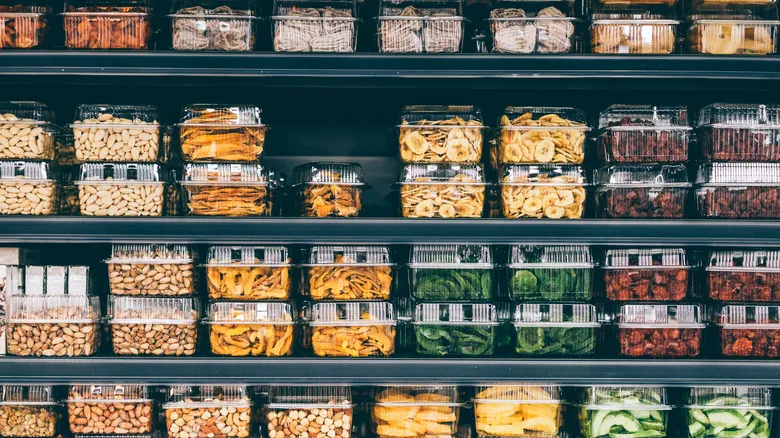
Why You Should Grab Perishable Groceries From The Back Of The Shelf
Next up

